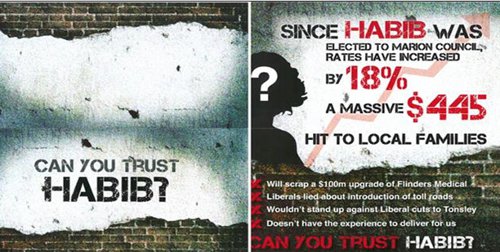The dust settled on the SA State election a couple of months ago and saw the Weatherill Labor returned with the support of an independent, Geoff Brock. Brock holds a seat in the Liberal Party's heartland in regional SA a fact when set alongside the Liberals winning 53 per cent of the two party preferred vote is cause for considerable chagrin. In my view greater cause for anger at the apparent 'unfairness' of the result lies with a development with campaign leafleting that has no place in Australian elections.
I recognise that negative campaign tactics have a place in election campaigns and know from research and interviews that campaign strategists are convinced negativity works in wooing undecided voters. What is so interesting about the recent campaign is that in the heat of campaigning Labor strategists willingly discarded any semblance of 'moral compass' to what might be acceptable campaign leafleting and embraced a hyper 'whatever it takes' ethos.
The fact that Labor's State Secretary sanctioned the leaflet pictured below focusing on Liberal candidate Carolyn Habib's surname places this instance of a negative attack into a different realm from the unauthorized leaflet distribution in Lindsay.
Advertisement
Such shameless dog whistling played a part in Labor narrow victory but it is impossible to surmise how many swinging voters were swayed away from supporting Habib. Not surprisingly drew condemnation among Liberals, unconvincing defence from Labor claiming it was not racist and widespread media coverage in SA and nationally.

The stress upon Habib's surname and the deliberate absence of her first name combine with the invocation to voters to reflect on 'TRUST' set against a wall that conjures a war zone serves a targeted purpose. Namely to imply that Habib is trouble akin to what you'd expect to find with with the strife we observe bedevilling Middle-Eastern countries and possibly terrorism.
The leaflet's background imagery begs the question – why this particular imagery and not the standard for negative campaign pamphleteering such as the bland background used by Labor only in its attack upon the Liberal candidate in the electorate of Hartley? Notable in Hartley was use of the candidate's first name, prompting the obvious question, 'why was not the same employed in the case of Carolyn Habib?' Perhaps 'Carolyn' does not sound sufficiently dubious for a pitch that aims to stereotype and smear.

Habib explained to me that she wanted to counterattack with a leaflet saying 'I'm a Christian, born in Australia'. Shechose not to feeling that such would lend itself to view that to be otherwise, especially Muslim and not born in Australian, simply entertained the same prejudices of those who issued the leaflet. She clearly understands how stereotypes resonate, a matter that one figures should be de rigueur for an inner urban Labor campaign team.
Advertisement
If you are not convinced by my assertion about the considered nature of the intention here, consider any number of Labor, or Liberal for that matter, negative attack pamphlets. The example above attacking Liberal candidate Vincent Tarzia employs the common negative methodology whereby a candidate features in grim looking picture - often photo-shopped – accompanied by a set of exaggerated claims of maleficence and, significantly, set against a relatively neutral background.
There is no way to gauge whether the leaflet swung a sufficient number of voters. If Labor received 400 less votes out of about 21,000 formal votes in Elder, Habib would probably have won.
Clearly, negative attack advertising is aimed at attracting the attention of the largely disengaged swinging voters [i.e voters not strongly committed or habitual with regard to the party they support] and strives, in some instances, to foster fear in voters' minds about what might be the outcome of their vote. More than anything the negative pitch is more likely to be remembered by swinging voters than the positive. As Pamela Williams reported the Liberal Party in the lead up to the 1996 national election studied 25 years of campaign adverts and concluded unequivocally that the negative pitch worked the best when it comes to swaying swinging voters, a view supported by Sally Young in her insightful research on political advertising.
Discuss in our Forums
See what other readers are saying about this article!
Click here to read & post comments.
1 post so far.